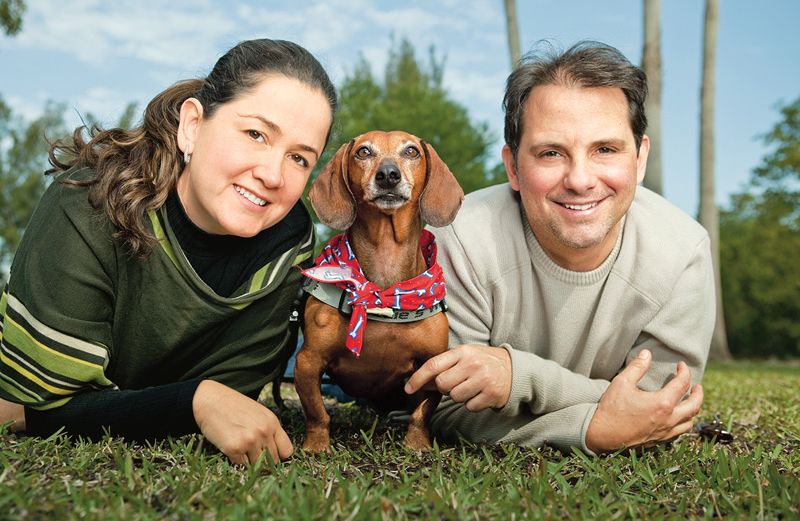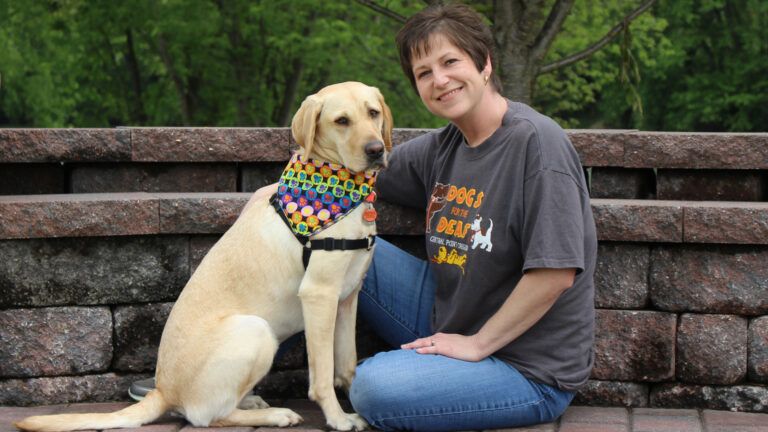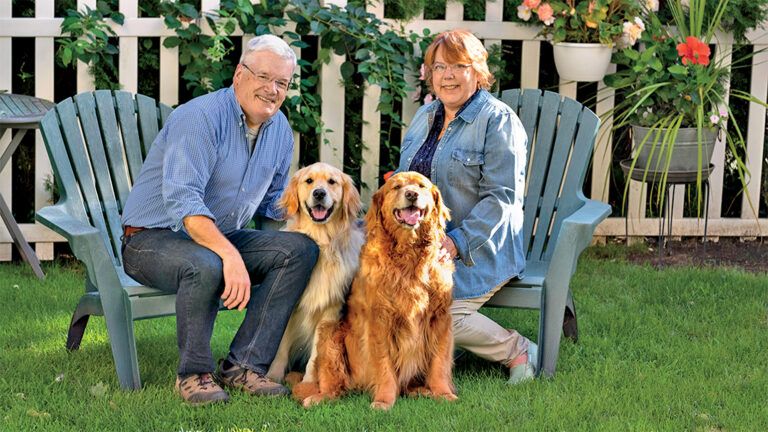I punched off the alarm and lingered in bed, feeling the warmth of our dachshund curled on top of the blanket.
Lance always slept on the bed when my husband, Caio, was away in Brazil on business. Four and a half years old, Lance was intelligent, playful, affectionate, with a slender tail that never stopped wagging.
But for Caio and me, he was more than just good company. We’d been unable to have kids, and Lance filled a big place in our lives.
I climbed out of bed and set him on the floor. “Maybe you’ll come to the office today,” I said. The ad agency where I worked was dog friendly. Halfway to the kitchen I realized there was no patter of paws behind me. I went back to the bedroom. Lance was in the same place.
“Come on, let’s go for a walk!” I said. Even this magic word failed to budge him. He stared at me with a strange pleading look in his brown eyes. I went to the kitchen and came back with a treat.
“Ground turkey, Lance!” He heaved himself up on his front legs and lurched toward me, dragging his rear legs. How had they suddenly become useless?
Frightened, I wrapped him in his blanket and took him to the animal hospital. The whole way there, Lance kept that imploring gaze on me. The vet made the diagnosis.
“It’s a ruptured disc pressing on the spinal cord,” he said. A common condition with dachshunds, usually correctable with surgery. “The sooner it’s done, the better his chances will be.”
The vet added that there was a 25 percent chance the operation would fail, but I was certain that between surgery and prayers, our dog would be healed.
I phoned my boss I wouldn’t be in and then reached Caio in Brazil. He cancelled his appointments and booked the next flight home, which wouldn’t get him here till the next day.
I was alone in the waiting room. Not a comforting space like the prayer corner I’d set up in our bedroom, but that wasn’t going to stop me from praying fervently for our Lance.
At last the surgery was over and I was allowed to see him. His back was shaved to bare skin, stitches closing a five-inch incision. With every breath came a moan of pain. The next three days Caio and I practically lived at the animal hospital. Lance was miserable, his eyes begging, Take me home!
“Soon you’ll be back in the park again, chasing your ball, making friends with all the kids,” I promised.
At home Lance had to be crated for 45 days. We found a mesh-sided box he could see out of and fitted it with cushions and his favorite toys. Within a few days the pain was gone and Lance was in his customary high spirits, flipping his red ball around with his nose.
But the weeks passed, and he didn’t seem to be regaining the use of his back legs.
I e-mailed other dachshund owners. One of them recommended an animal physical therapist, Dr. Martha Sanchez. She tried herbal medicine, acupuncture and water therapy–to no avail. Lance was still pulling himself forward with his front legs, dragging his hindquarters pathetically behind him.
Since he couldn’t wag his tail, he learned to express his feelings with his floppy ears, wiggling them to signal delight, hunching them back when he was anxious. Every day I knelt in the prayer corner of our bedroom, begging God to heal our dog.
Two months after surgery we learned of the veterinary school at the University of Florida in Gainesville. They had an MRI machine for small animals and a world-famous veterinary neurosurgeon, Dr. Roger Clemmons.
Through the friend of a friend we got an appointment and drove the five hours north.
Dr. Clemmons looked like the mad scientist in Back to the Future, white hair flying, a troop of students at his heels. Six of them crowded about him as he gave us the result of his tests. “The spinal cord is severed,” he told us. “I’m sorry, but your dog is permanently paralyzed.”
Paralyzed…I knew what came next. E-mails, chat rooms, veterinary journals–they all said the kindest thing was to put the dog down. But not Lance! Not our uncomplaining little dog, pulling himself so valiantly along the floor. He seemed so determined to survive.
I went back to my prayer corner, and Lance went back to sessions with Dr. Sanchez to strengthen the front part of his body. Wasn’t there anything more we could do? I asked Dr. Sanchez.
“You could try Eddie’s Wheels,” she said. Ed Grinnell was a mechanical engineer in Maine whose Doberman pinscher had a damaged spine. He’d constructed a metal frame attached to a pair of wheels, which took the place of his dog’s back legs.
Now he manufactured and sold these “wheelchairs for dogs” all over the world.
Caio and I went to the website and filled out the order form: Lance’s weight, length and other measurements. Two months later a little chariot arrived at Dr. Sanchez’s clinic for fitting and final adjustments. The aluminum frame was incredibly light, the wheels on their ball bearings spun at the merest tap.
“It will take Lance a while to get used to it,” the doctor cautioned as she lifted his hindquarters onto the saddle between the wheels. “Some dogs adjust to it in a week or two, others take longer.”
It took Lance all of one second. The moment Dr. Sanchez set him on the floor in the contraption, he was off, circling the clinic, careening around corners with little yips of joy.
Soon Lance was back in the park chasing his red ball. People were intrigued by his wheelchair. Kids loved it and he loved them right back, nuzzling and licking them, yipping and wiggling his ears to express what his tail no longer could.
“He’d make a great therapy dog for kids,” someone said. Caio and I looked at each other. A dog in a wheelchair–what an inspiration in a children’s hospital!
We had to be interviewed by a therapy dog trainer first. Caio and I answered dozens of questions. How well did we control our dog? Could we commit regular hours to this work? Hardest of all: How would we react to being around children in pain?
Lance sailed through tests for obedience, intelligence and gentleness. On “likes children,” he was over the top. During training he was exposed to the smells of a hospital, the shriek of sirens, the rattle of meal carts, the racing feet of an emergency team. None of it fazed him.
Still, we were apprehensive the first time we took him to Miami Children’s Hospital. What I was most concerned about was that he’d greet kids with his happy yipping.
“No barking” was rule one for therapy dogs. But how do you tell an excited dachshund not to bark? We didn’t have to. From the moment we stepped into the hospital lobby, not a sound came from him.
As though he knew exactly what he was there for, he followed the nurses in and out of the young patients’ rooms, silent and chipper–a real pro.
And the faces of those kids when they saw him! In the first room Caio lifted Lance up so the little girl in the bed could pet him. I worried that he’d bestow on her some of his affectionate licks–strictly forbidden in this sanitary setting.
But with that same uncanny sensitivity to the situation, Lance didn’t let so much as the tip of his tongue slip out as the girl stroked him, giggling. Her mother followed us into the corridor. “In the two months she’s been here,” she said, “this is the first time she’s laughed.”
Later that day, a boy in leg braces crossed the room, his gait unsteady but determined. He had eyes only for our dog. The boy reached Lance and gave him a kiss. The nurse told us afterward he’d never before walked alone.
Caio and I put together a booklet telling Lance’s story. An artist drew cartoons of “Super Lance,” a photographer took his picture, another friend designed a connect-the-dots portrait of Lance, a company that worked for the ad agency did the printing free.
We’ve given the booklets to more than 1,000 children. Right before we leave for each hospital visit, I stop at that bedroom corner to thank God for answering our prayers. Not the way Caio and I wanted, but I’m learning that when the answers aren’t what we ask for, these are the times to look for something even better.
This was God’s answer, for a little girl who couldn’t laugh and a little boy who couldn’t walk and a couple who couldn’t have children of their own. An answer more fulfilling, more creative, more wonderful than anything we could have wished for.





